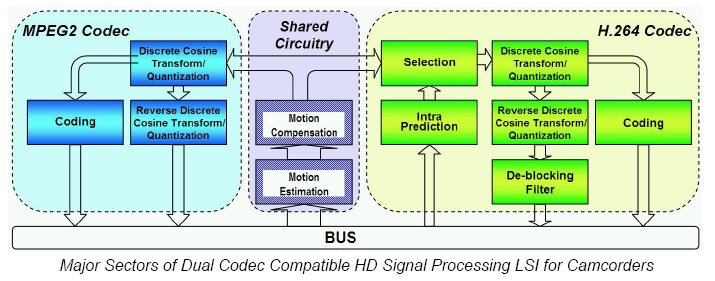JVC Develops Dual Codec Compatible HD Signal Processing LSI for Camcorders
Monday, June 9th, 2008TOKYO — JVC (Victor Company of Japan, Ltd.) has become the first in the industry to develop a “Dual Codec Compatible HD Signal Processing LSI for Camcorders” that supports two high-definition signal compression formats. This technology makes it possible to choose while shooting between the H.264/MPEG-4 AVC format which is suited for long-time high quality recording, and the MPEG-2 format which offers high bit rate stability as well as superior association with the current environment for video editing. This makes it possible for JVC to develop high-definition camcorders that address a wide variety of user environments.
JVC is a leader in a number of digital data compression technologies, and is evaluated highly in the visual content production area. The company’s track record in the field includes the release in spring of 2007 of the world’s first consumer camcorder to offer 1920 x 1080 Full HD recording, the HD Everio model GZ-HD7 equipped with the “HD Gigabrid” high picture quality image processing engine. This as well as subsequent models adopting the high bit rate MPEG-2 format gained praise from many customers for JVC.
Since then, demand in the camcorder market for high-definition content grew rapidly and the user editing environment became more diverse. This signals the need for future high-definition camcorders to offer flexible compatibility. JVC addressed such diversified user needs by developing this dual codec compatible HD signal processing LSI for camcorders that supports the two HD recording formats H.264 and MPEG-2, and installing it in the evolving image processing engine “HD Gigabrid Duo”.
Main Characteristics of the Dual Codec Compatible HD Signal Processing LSI for Camcorders
1. The LSI supports recording and playback of high-definition video in both the H.264/MPEG-4 AVC format which is suited for high quality long-time recording, and the MPEG-2 format which offers high bit rate stability as well as superior association with the current video editing environment.
2. JVC equipped the LSI with interfaces essential for camcorders such as IDE, SD card slot and USB to accommodate a wide range of possible applications.
3. JVC made it possible to develop a wide range of high-performance products in a short timeframe by using a common platform for both consumer HD camcorders and professional HD video cameras.
TECHNICAL HIGHLIGHTS
1. Optimized for High-Definition (HD) Camcorders
JVC capitalized on the high compression efficiency of the system’s base H.264 codec technology to develop a new algorithm enabling high-quality encoding of Full HD (1920 x 1080 pixel) sized images, creating an optimal system for high-definition camcorders. As the H.264 format becomes more popular, JVC made a commitment to providing high picture quality playback in H.264, thereby offering superior affinity with next-generation HD recorders.
2. Achieves Long Recording Time with High Picture Quality
JVC improveed picture quality for low bit rate recording by fine-tuning the codec algorithm. JVC can now offer long-time recording of finely detailed Full HD (1920×1080 pixel) images at a low 5 Mbps bit rate through dynamic control and optimizing the recording bit rate.
3. High System Expandability
JVC made it possible to accommodate the current editing environment as well as export this technology to professional video cameras with a minimal investment for system expansion, recognizing the importance of recording in MPEG-2 format which accounts for a wealth of visual content. As a result, JVC achieved high bit rate (27 Mbps) high quality recording. Moreover, JVC also designed this system to record to various types of recording media.
4. Dual Codec Achieved in Minimal Circuit Size
The calculation load of Motion Estimation (ME) and other processes may become very large during H.264 encoding and decoding. This requires more sophisticated processing than for conventional MPEG-2. JVC optimized the codec processing algorithm to accelerate processing speeds to solve this issue. Moreover, JVC also achieves faster processing by using a specialized DMA circuit for external memory access.
5. Focusing attention on Common Blocks and Optimizing Die Size
JVC achieved the minimal size circuit even while including the dual codec by integrating part of the Motion Estimation (ME) and Motion Compensation (MC) blocks, and by sharing internal memory.

6. Efficient Front and Back End Systemization
JVC could achieve an HD signal processing system that records without any degradation of the high definition signal received from the camera block. JVC provides efficient signal processing by combining a camera processing LSI that supports various types of image sensors in front of the HD Signal Processing LSI.
Latest News
- Barb to start reporting TV-set viewing of YouTube channels
- SAT FILM selects multi-DRM from CryptoGuard
- Qvest and ARABSAT to launch OTT streaming platform
- ArabyAds & LG Ad Solutions partner with TVekstra in Turkey
- Freeview NZ satellite TV service to move to Koreasat 6
- Comscore expands YouTube CTV measurement internationally
